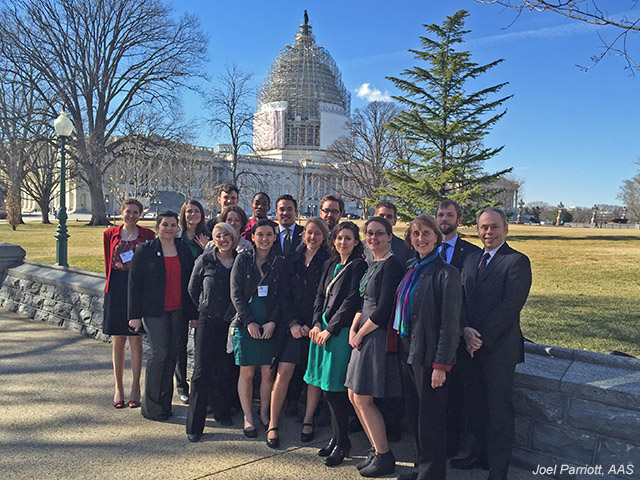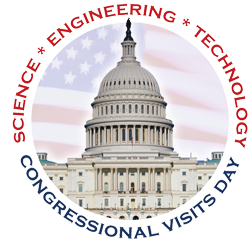An Early Introduction to Advocating for the Astronomical Sciences
This guest post comes from Ashley Tucker, an undergraduate at St. John's University in New York and a Society of Physics Students affiliate of the AAS.
— Joel Parriott, AAS Director of Public Policy
From 16 to 18 March 2015, I had the pleasure of participating in Congressional Visits Day (CVD), an annual event that brings researchers, educators, and other professionals to Washington, DC, to raise visibility and support for science, engineering, and technology. As one of only two undergraduates in the AAS contingent, I was among the youngest participants. It was a wonderful experience.
I arrived in DC on Monday morning and was late to the optional orientation at the AAS Executive Office — I accidentally exited the Dupont Circle Metro station to the south, whereas the AAS is to the north, so I had an unexpected 20-minute walk. I arrived, walked into the room, and discovered that I wasn't as late as I thought. Put another way, I wasn't the only one who was late; I suppose it's understandable when people are converging on a not-entirely-familiar city from all over the country. We were welcomed enthusiastically and provided with coffee and snacks.
I had been to Washington a few other times. As a child I saw it as the US capital, an exciting place of museums and important buildings. As an adult I saw it as the center of US politics, with Congress essentially run by a bunch of 20- and 30-somethings, i.e., the staffers who support the various House and Senate members. Well, at least they're my demographic! The orientation on that first day touched on this notion and many others: how a bill becomes a law, how America ranks in research spending, how much money we are working with, etc. Then there was a training session with Anna Quider, the Director of Federal Relations at Northern Illinois University, on what it's like to be a lobbyist vs. a member of Congress. You argue your point to the fullest extent with little to no middle ground; that's what lobbyists are paid to do. The last presentation of the day was given by Paul Hertz, the director of NASA's Astrophysics Division, and was catered with wine and cheese, which I think all of us much appreciated.
AAS participants in CVD 2015 at the US Capitol building. Author Ashley Tucker is at far left.
After that first day's meetings, we split off and went to dinner. I went with colleagues to Daikaya, a ramen restaurant, and then it was time to call it a night. I was running on only two hours of sleep, and I'm sure many others were too.
The next morning we were back at the AAS for breakfast. There were new faces and more presentations. We heard from Kevin Marvel of the AAS, Jim Ulvestad of the National Science Foundation (NSF), and Lika Guhathakurta of NASA. Then we split off into our assigned groups and devised our game plan for the next day, when we would meet with members of Congress and/or their staffers. Our main goal would be to keep it personal. These are politicians elected by the people, after all, and while they might have their own agendas, they still care about the votes. We'd need to be careful about how we talked: fancy science jargon wouldn't cut it. We'd need to relate to the people we'd be meeting with and have a conversation, not deliver a lecture.
"Hello, how are you?”
“Where are you from?"
"What do you do for the representative/senator?"
The point would be to make an impression in an effort to keep open communication in the future. Since I'm not currently working on research and I'm an undergraduate, my angle would be how I became interested in astronomy. I would begin by talking about the Young Astronauts Club, which I joined when I was in 5th grade. It was after being a part of that club that I knew I wanted to be an astronomer or astrophysicist. A personal story like this is a great way to address the importance of STEM education and how astronomy is a gateway science, as it most certainly was for me. My colleagues, being much further along in the field than I am, would offer different angles. We would also touch on inventions and discoveries that happened as a result of astronomy. Our official Orange Team consisted of John O’Meara (St. Michael’s College), Adam Kobelski (National Radio Astronomy Observatory, NRAO), and Marcel Agueros (Columbia University), who unfortunately couldn’t make it in person but remained in contact throughout CVD. After the morning's discussion we learned that something went wrong with the lunch delivery, so off we went to eat and then head to the Capitol Visitor's Center.
We arrived at the Visitor’s Center auditorium for the CVD Educational Program, in which we reviewed the budget background, learned about the different perspectives of Hill and White House staffs, and heard an informative panel discussion, “Telling Your Story with Data.” The panelists were Kei Koizumi (White House Office of Science and Technology Policy, OSTP), Matt Hourihan and Sean Gallagher (American Association for the Advancement of Science, AAAS), and former Tennessee Congressman Bart Gordon (K&L Gates). We learned more about what to expect, the various priorities of the members, and how to use data to support our cause. After the program we traveled to Cannon Caucus Room 345 for exhibits and a reception, after which we went out for dinner.The next morning we met at the Longworth House cafeteria to debrief and eat breakfast before heading out for the day. After breakfast Adam and I scoped out the offices while John met with his senator for coffee. Then we went to our colleague Stuart’s meeting with a staff member of Representative Katherine Clark of Massachusetts. It was helpful to get an idea of what to expect before attending our own meetings, and they did go smoothly. The group split up at times throughout the day when the meetings were longer distances from each other, in an effort to make sure we were there on time.
Aside from Stuart’s meeting, I attended three gatherings with staff members of my senators and representatives, as well as two of Adam’s meetings with staff members of his senators from West Virginia. The staffers Adam met with were very interested in NRAO, which has a site next door in Virginia, whereas the staffers of my congresspersons from New Jersey didn't have any specific interests related to astronomy. Representative Rodney Frelinghuysen’s staff member kept it short and simple by listening attentively and not asking many questions. The staff member for Senator Cory Booker was interested in statistics and wants to have a “State of the Universe” session for the Senate like the one that took place in the House of Representatives in February 2014. Senator Bob Menendez's staffer wanted statistics on astronomy activity in New Jersey, noting that New Jersey is better known for its biomedical research. By the end of the week, I put together a comprehensive overview on astronomy in New Jersey and sent it to the staff members I met with from that state.
After meeting with the congressional staffers, Adam and I joined the rest of the AAS group and headed to the New Executive Office Building for a meeting with staff members from the Office of Management and Budget (OMB) and OSTP. It was very informative to learn about their backgrounds and responsibilities and a privilege to be able to ask them questions. OMB oversees many policies and programs for the White House, while OSTP advises the administration on the intersection of science and technology with domestic and international affairs.
As the day came to an end, some of us went out for drinks and food before splitting up to head home. I learned a great deal from the CVD experience and met many people who have now made an imprint on my life. I am grateful to have participated.



